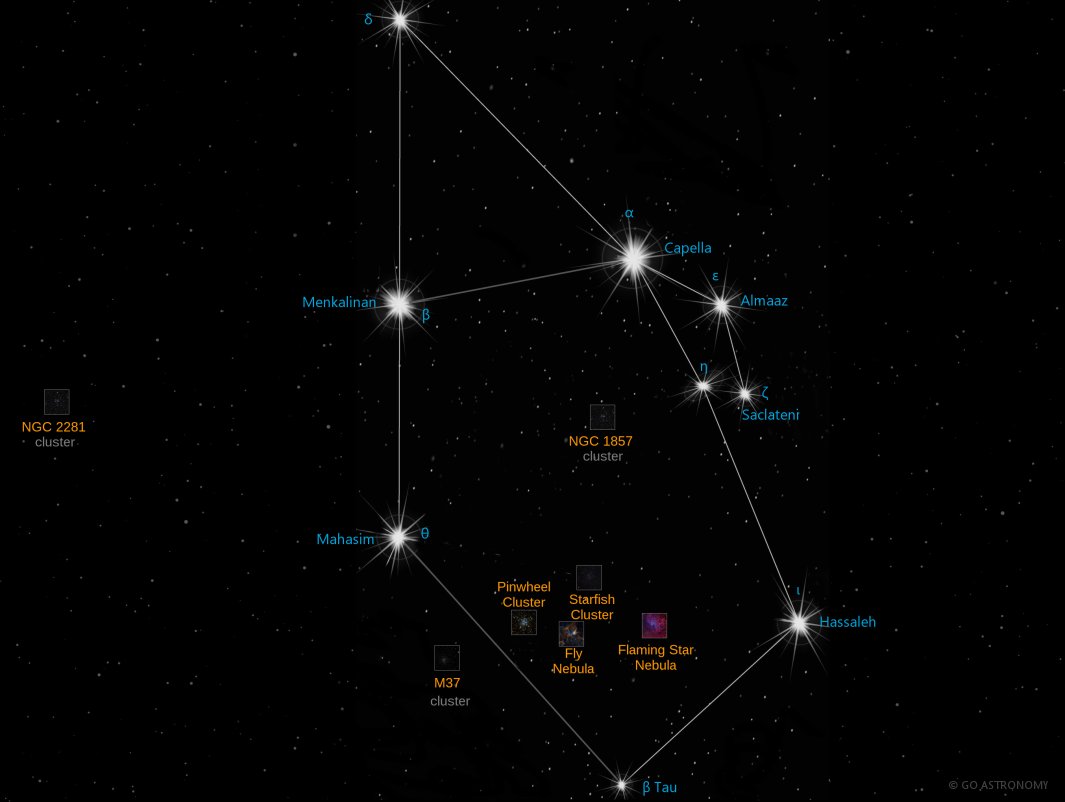Auriga, the Charioteer (Aur)
(aw-RYE-guh)
The Northern constellation of Auriga, the Charioteer, is best viewed in Winter during the month of February.
Auriga is the 21st largest constellation. It's brightest star is Capella at magnitude 0.80. The boundary of the Auriga constellation contains 8 stars that host known exoplanets.
- Pronunciation:
- aw-RYE-guh
- Meaning:
- Charioteer
- Genitive:
- Aurigae
- Abbreviation:
- Aur
- Asterism:
- Winter Hexagon
- Constellation Family:
- Perseus
- Hemisphere:
- Northern
- Quadrant:
- NQ2
- Visibility:
- 90° N - 40° S
- Best viewing month*:
- February
- Area:
- 657 sq. degrees
- Size:
- 21st largest
- Right Ascension (avg):
- 5h 57m
- Declination (avg):
- 40°
- Meteor showers:
- Aurigids
- Brightest star:
- Capella (0.80)
- Stars with planets:
- 8
- X-ray stars:
- 4 (2 binaries) stars
Brightest Stars in Auriga
The 10 brightest stars in the constellation Auriga by magnitude.
- Star
- Magnitude
- Spectral class
- Alpha Aurigae (α Aur)
- 0.08
- G8III / G0III
- Beta Aurigae (β Aur)
- 1.9
- A2V
- Theta Aurigae (θ Aur)
- 2.62
- A0p Si
- Iota Aurigae (ι Aur)
- 2.69
- K3IIvar
- Epsilon Aurigae (ε Aur)
- 3.03
- F0Ia
- Eta Aurigae (η Aur)
- 3.18
- B3V
- Zeta Aurigae (ζ Aur)
- 3.69
- K4II
- Delta Aurigae (δ Aur)
- 3.72
- K0III
- Nu Aurigae (ν Aur)
- 3.97
- K0III
- Pi Aurigae (π Aur)
- 4.3
- M3IIvar
Double Stars in Auriga
These are the brightest and easiest-to-find double, triple, and quadruple star systems in the constellation Auriga . Also see all star clusters.
- Star system
- Magnitudes
- Type
- Theta Aurigae
- 2.6, 7.2
- double
Star Clusters in Auriga
The most notable and easy-to-find star clusters in the constellation Auriga . Also see all star clusters.
- Star cluster
- Catalog #
- Cluster type
- Messier 36
- M36
- open
- Messier 37
- M37
- open
- Messier 38
- M38
- open
- NGC 1931
- open
- Palomar 2
- globular
- Teutsch 2
- open
Nebulae in Auriga
Notable and easy-to-find nebulae in the constellation Auriga. Also see all nebulae.
- Nebula name
- Catalog #
- Nebula type
- Flaming Star Nebula
- C31
- reflection
- Fly Nebula
- reflection
- Westbrook Nebula
- protoplanetary
The Charioteer of the Stars
Auriga, derived from the Latin term for 'Charioteer', is a prominent constellation in the Northern Hemisphere, celebrated for its historical context, interesting mythology, and engaging astronomical features. Bright stars and unique deep-sky objects make Auriga an attractive constellation for both casual stargazers and seasoned astronomers.
History and Mythology
Among the 48 constellations listed by the 2nd-century astronomer Claudius Ptolemy, Auriga continues to be one of the 88 modern constellations recognized by the International Astronomical Union. Its image as a charioteer has origins in ancient Greek astronomy, although various interpretations and legends surround this celestial entity. The constellation is often associated with Erichthonius, a mythical king of Athens who was credited with inventing the four-horse chariot.
Location and Main Features
Occupying an area of 657 square degrees, Auriga is situated in the second quadrant of the Northern hemisphere (NQ2) and can be seen at latitudes between +90? and -40?. It is surrounded by constellations such as Gemini, Lynx, Perseus, and Taurus.
Auriga is notable for its pentagonal shape, the most conspicuous star being Capella (Alpha Aurigae), the sixth brightest star in the night sky. This yellow giant star lies approximately 43 light-years from Earth and has a magnitude of 0.08, rendering it visible even from light-polluted locations. Other major stars include Menkalinan (Beta Aurigae), a binary star system, and the variable star Epsilon Aurigae.
Deep Sky Objects
Amidst its celestial expanse, Auriga is home to several impressive deep-sky objects. The constellation features a plethora of open star clusters, such as M36, M37, and M38, which are remnants of ancient stellar nurseries. These Messier objects make Auriga a popular target for stargazers armed with small telescopes or binoculars. Another deep-sky object of interest is the Flaming Star Nebula (IC 405), a colorful emission and reflection nebula approximately 1500 light-years away.
Observing Auriga
Auriga's position and bright stars make it relatively easy to locate. Visible throughout winter in the Northern Hemisphere, the constellation can be spotted by looking for its brightest star, Capella, which is part of the Winter Hexagon asterism. Its other stars and clusters, while not as bright as Capella, can be observed with a modest telescope or binoculars from a dark-sky location.
For the amateur astronomer, the challenge and pleasure lie in tracking down and viewing its deep-sky objects, especially the open clusters. M36, M37, and M38, in particular, provide a stunning celestial view. The Flaming Star Nebula, with its interplay of red emission and blue reflection areas, is also a sight to behold for those with more advanced equipment.
* Constellation shown for northen hemisphere skies. For the southern hemisphere, constellations appear rotated 180 degrees (upside-down and left-right reversed) from what is shown. Remember that seasons are reversed too - summer in northern latitudes is winter in southern latitudes.
** Circumpolar constellations are visible year-round in the hemisphere listed (and not at all in the opposite hemisphere).





